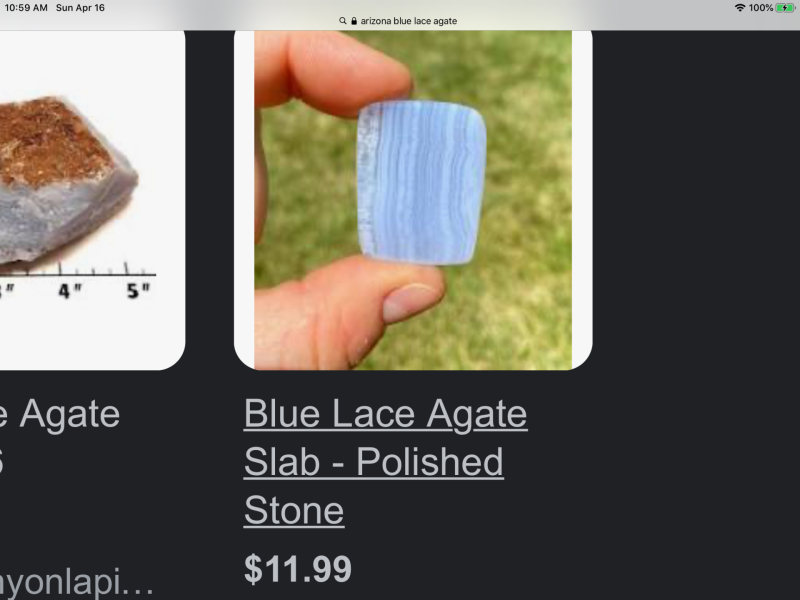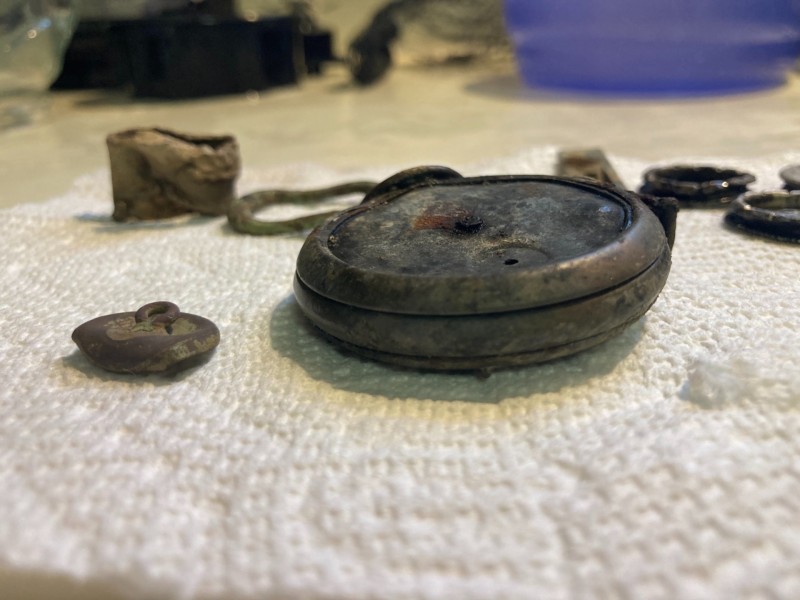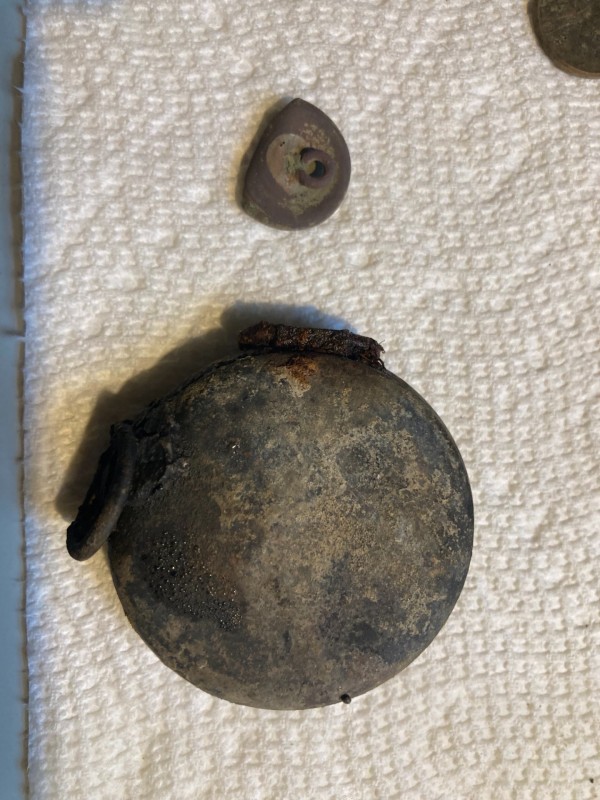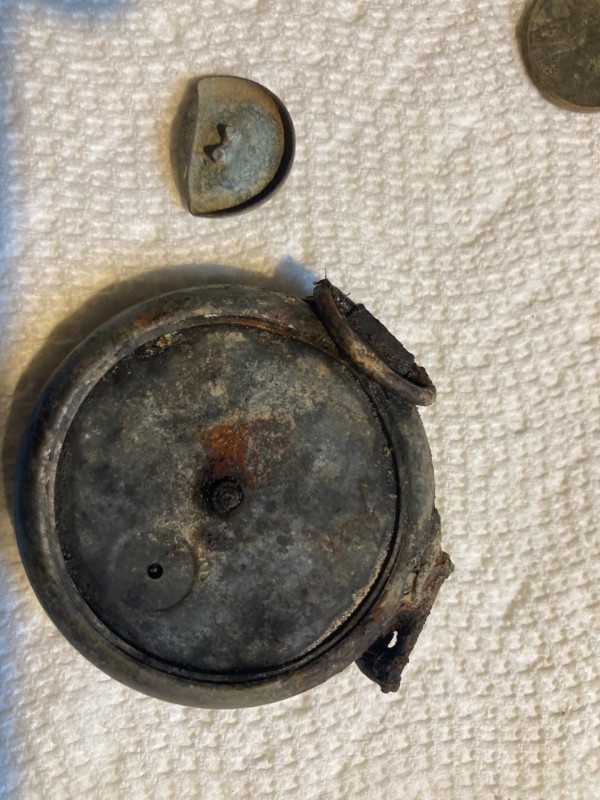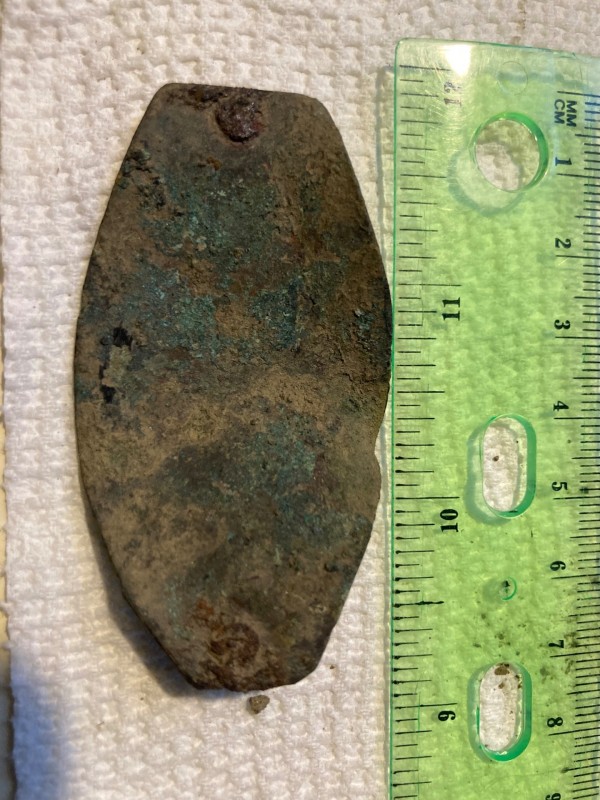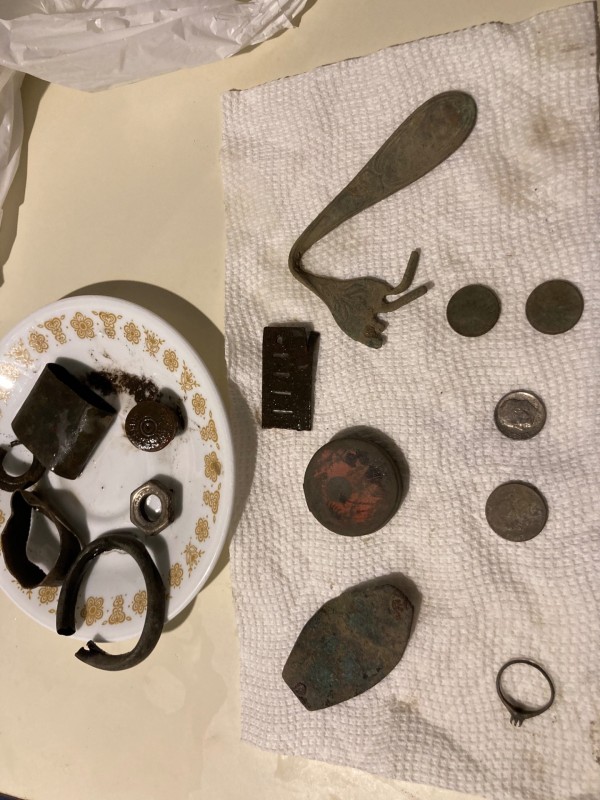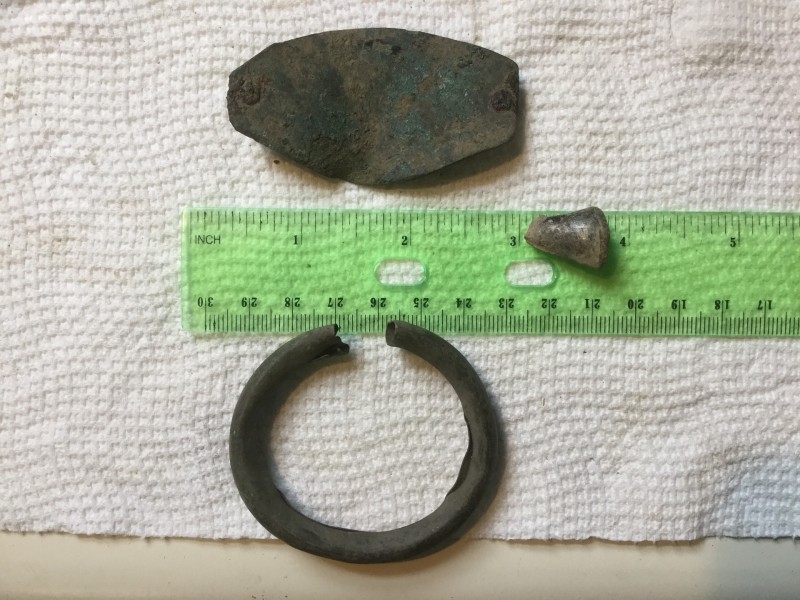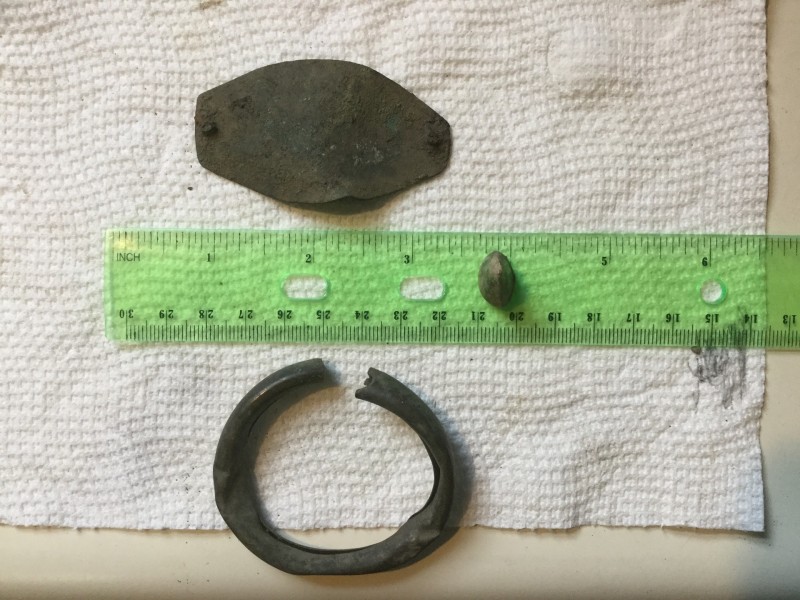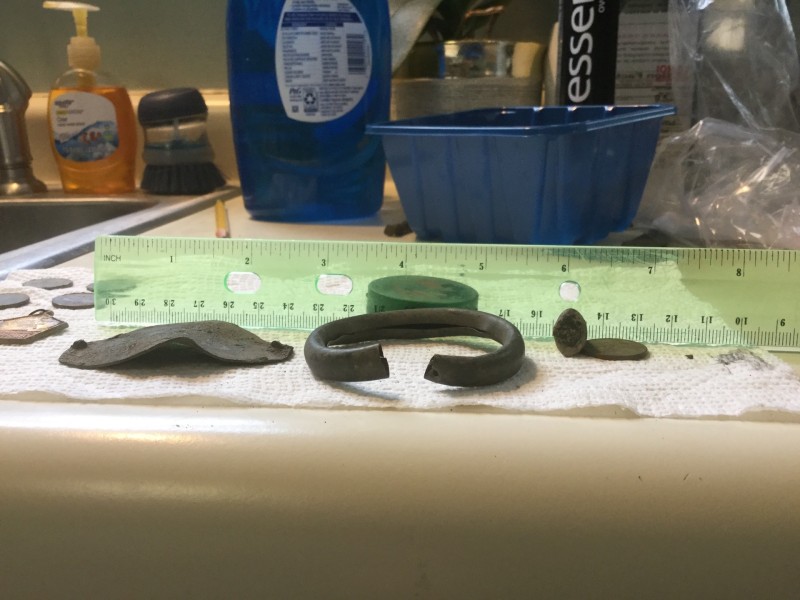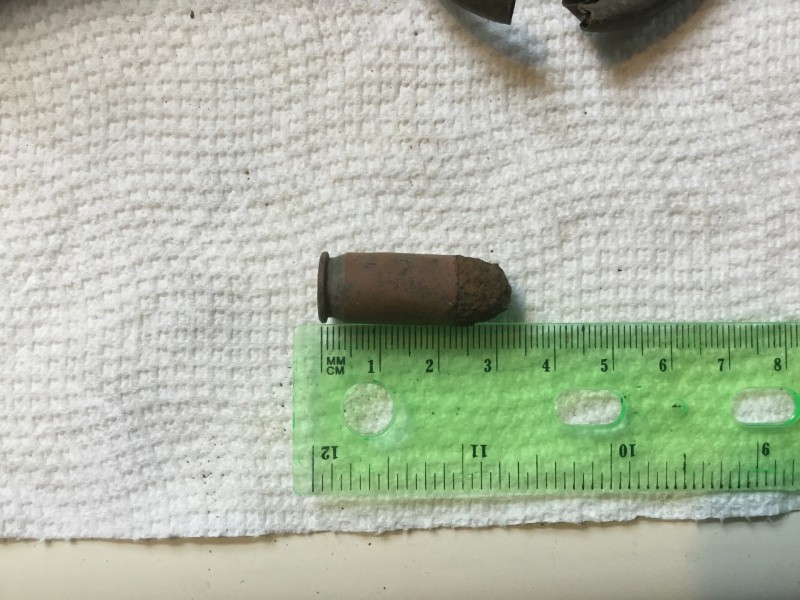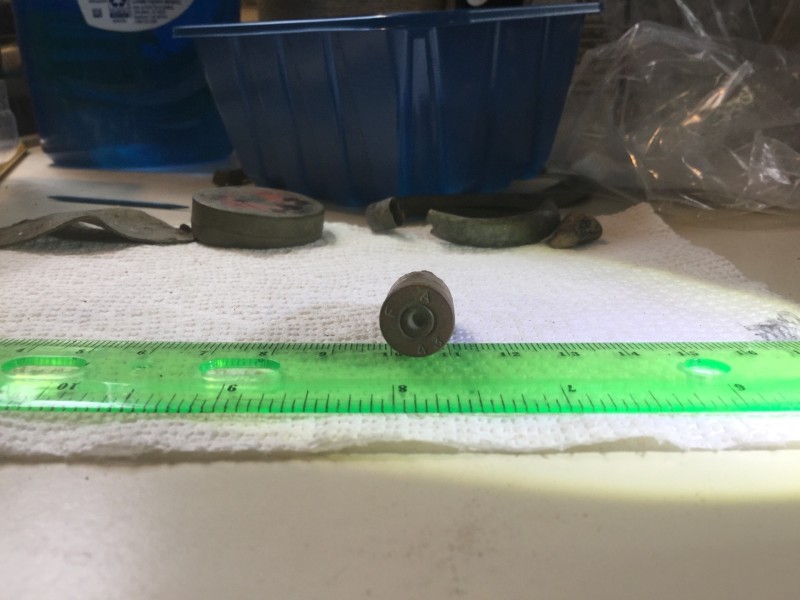-
Posts
339 -
Joined
-
Last visited
Content Type
Forums
Detector Prospector Home
Detector Database
Downloads
Everything posted by Geologyhound
-
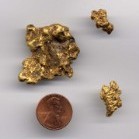
Strange Rock Found While Metal Detecting
Geologyhound replied to The Pest's topic in Rocks, Minerals, Gems & Geology
You can buy hardness test kits, but unless you’re going to do this a lot you can probably make do with items on hand. If you have a broken ceramic pot or a porous ceramic plant pot or a piece of unfinished ceramic tile, any of those would do. You want white ceramic/porcelain. Otherwise you may have trouble discerning the true streak color. The idea here is minerals softer than your streak plate will leave a characteristic streak color. Minerals harder than your streak plate won’t. Either way, it is an important diagnostic indicator. -

Strange Rock Found While Metal Detecting
Geologyhound replied to The Pest's topic in Rocks, Minerals, Gems & Geology
Some common things you might have on hand to test hardness: your finger nail (about 2.5), a copper - not zinc but copper - penny (about 3.5), A pocket knife blade (about 5.5), glass (about 5.5 to 7), a steel nail (about 6.5). There is a difference between scratching and pushing hard enough to break the surface of the sample - especially if using a pointed object like a nail. With the exception of your finger nail, try using the rock to scratch each of these items. You can use your finger nail to scratch the rock. As jasong mentioned, definitely use unglazed porcelain for the streak test. Post your results back here and we’ll see what we can do! -

Retirement Has Given Me The Time To Try Something New
Geologyhound replied to SilverSteve's topic in Meet & Greet
Yep, no silly questions, but we might have some silly answers!🤪 You’ll get some good help here - there are a lot of knowledgeable people. So, do you have a detector yet or are you still looking? -
Looks like it might be a piece of blue lace agate. There is a wide variety to the color and pattern, but a picture of a typical piece is attached. If your stone scratches glass, that would be a good indicator of agate. Agate will be much harder than calcite, but not as hard as ruby, sapphire or diamond. Agate is relatively tough – I have dropped an agate slab on a concrete floor before without it breaking. I wouldn’t advise trying it too often... Agate will be best if shaped and polished - don’t try to facet it. I would try to make sure that the finished stone doesn’t have any fractures. You’ll either need to go to a jeweler to have a ring custom-made to fit the stones, or you’ll have to have the stones cut to a predetermined size and shape to fit a standard ring. Were you planning on turning this into a finished product yourself or were you going to take it to a jeweler or lapidary? If you are planning on turning this into two rings, be aware that it will have to be cut in half, and the trim saw blade thickness will take a chunk out of the size. Depending on what you envision for the final rings, you might need to find a larger piece. There are Internet maps available of rock hounding locations in Arizona and what can be found at those locations. You could always buy some rough stones online, but I am guessing you want the stone to be something he found and would prefer it to be out of a single piece, correct?
-

I Determine How Much Ai Understands About Gold Detecting
Geologyhound replied to jasong's topic in Detector Prospector Forum
Now if only we could ask it where to go to find gold coins, valuable rings, or stashes with a metal detector... -
Alberta does have geodes and it looks like you are close to British Columbia. British Columbia has thundereggs. What you have has a little more filling then a typical geode, but less filling than a typical thunderegg. So, I would say it is sort of a gradation between the two. Just be careful of picking anything like that up on public lands. I understand that is against the law up there.
-

Does This Ore Have Some Gold?
Geologyhound replied to Marc's topic in Rocks, Minerals, Gems & Geology
Unfortunately, gold does not cleave into sheets or flat flakes. Shiny flakes sound like mica to me. That would be a sheet silicate (phyllosilicate). Muscovite can occur in a range of colors (including orangey and goldish) depending on the impurities. I imagine when you swish the water in your pan, those flakes move fairly easily? Gold, being dense, would settle into the bottom crease of your pan and not move very easily. -

Please Help Identify. Can Not Find Anything Like It?
Geologyhound replied to Heb's topic in Rocks, Minerals, Gems & Geology
A portion of the lower part of the broken surface appears to have the scalloped appearance typical of conchoidial fracturing. This is something I would expect to find in fine grained silicates (like a agate, chert, or obsidian). Yet, the top portion very definitely appears to have grains weathering out of the groundmass. It scratches porcelain, so that rules out the typical hematite and ironstone nodules, but is the hard portion the grains? I concur with Jasong the little streak color you got was from surface residue/oxidation. Let’s rule out some other possibilities. If you have any dilute hydrochloric acid, drip some one some of the surfaces. If it fizzes, you have some calcite cementation. In that case, try to figure out exactly what fizzes.- 34 replies
-

2nd 1909s Wheat In A Month
Geologyhound replied to Zincoln's topic in Metal Detecting For Coins & Relics
Only place in my life I’ve ever seen the central bulge of the Milky Way - camping out in Rabbit Basin. A long way from city lights… -

Please Help Identify. Can Not Find Anything Like It?
Geologyhound replied to Heb's topic in Rocks, Minerals, Gems & Geology
The older I get the more I’m convinced the less I know. I’m a geologist but I have never heard of gogottes before. So, nice post there Jasong! If it is some sort of gogotte, the density is puzzling. Those should be made of silica sand and calcium carbonate. That should not be that heavy. Heb, any chance you could do an Archimedes density test on it? Fill a basin with water clear full, immerse the object, measure the volume of water that overflows, weigh the object and calculate the density. Can you get a close-up of the matrix of the rock? Does it appear sandy or is it crystalline but too small make out the crystal size? Yes, a close-up of the crystal would be interesting too.- 34 replies
-

2nd 1909s Wheat In A Month
Geologyhound replied to Zincoln's topic in Metal Detecting For Coins & Relics
Born in the valley, raised in Coos County, OSU grad (go Beavers!), married and moved to Ohio. Still have a bunch of Madras thunder eggs and Rabbit Basin sun stones as well as some Holly blue. So, I still have a bit of Oregon with me.😁 -
Welcome back from a White’s XLT now an XP Deus 2 user!
-

2nd 1909s Wheat In A Month
Geologyhound replied to Zincoln's topic in Metal Detecting For Coins & Relics
Nice! The only 1909S I ever found was at an old school on the southern Oregon coast. It wasn’t in very good condition either… -

Any Professionals Ideas?
Geologyhound replied to Joseph 11's topic in Rocks, Minerals, Gems & Geology
Were these all found in the same location? I concur most of them look like slag or clinker. The green banded one without lots of air bubbles looks like some jasper I have in the back shed. -

Some Finds From A Union Camp
Geologyhound replied to Geologyhound's topic in Metal Detecting For Coins & Relics
Someone in a different forum sent me a picture of a pump organ reed. That is exactly what it looks like. Thanks! The knife grip is plastic. I was guessing at mid 1900s. Looks like there was a small oval plate affixed to one of the grips. But only a fragment of the plate is still present. I guess I need to start a bucket of “possible” Civil War items. 😁 Anybody know what range a Civil War bullet would ring up for the D2? -
This site has been in continuous use since the Civil War so there is a variety of ages to the items which can be found. The most interesting items are the button back, the old pocket watch, and the old pocket knife. The knife, the piece of rolled up scrap lead, and the belt buckle (modern style?) was found by my son on his first outing with my old detector. The lead and button back were in the “splash“ area of square nails from an old stockade. But, the 1957 penny was in the same general vicinity. There are no markings on the button back that I can see. So I am guessing it is probably not military but I would appreciate any input if it looks familiar to anyone. With a magnifying glass, I can make out fragments of a couple small letters on the back of the pocket watch - not enough to decipher. It looks like it was made to open. Not sure of the metal. It feels a little on the heavy side. The back might be brass. I am thinking the front might be steel. It rang up a solid 95 in a fire pit with blobs of aluminum, an old power saw blade, and tons of iron. So the whole watch was covered in a layer of black. There may be remnants of silver plate. I am guessing this is relatively recent? Not sure what the aluminum caps are. There is a crimp side to them like they were attached to a cardboard tube. This is the second shotgun shell (Western Super X number 12 paper case) I have found here. The rifle casing is FA 36 (Frankford Arsenal 1936). There is also one item which has a thin metal “flap“. I don’t know if this was some part of a music box? Thanks for looking and any help you can offer regarding some of the random items above.
-

Please Help Identify. Can Not Find Anything Like It?
Geologyhound replied to Heb's topic in Rocks, Minerals, Gems & Geology
When you say it has some sort of quartz embedded, do you mean it looks like it has sand fused onto it, or do you mean light transmits through it like an agate? There are several things that come to mind. Determining which is correct would be difficult without seeing the stone in person. The surface looks almost like pahoehoe (a kind of lava flow with a billowy or ropey surface). But, I would not expect that on both sides. The shape of it could be a sort of volcanic spatter bomb. However, those usually have air pockets. I concur with Ddancer that the surface morphology does appear roughly akin to some agates. But, you can also get some interesting surface textures with hematite nodules and ironstone nodules as VicR suggested. Since you said it is heavy, this makes me think it may be a nodule. If you scrape one edge of the broken part on a piece of unglazed porcelain and it leaves a red streak, then it is hematite. If the streak is more yellowy brown, then it could be limonite (a hydrated iron oxide). If it scratches the porcelain and doesn’t leave color behind, then it is a silicate (e.g. agate). Something to consider – the French did set off several nuclear devices in the Sahara when they were developing nuclear weapons. I understand they were lava blobs and fused sand blobs found, but I haven’t seen pictures. It does not look like any of the nuclear fused glass discovered after the American nuclear tests. Were you, by any chance, anywhere near where the nuclear testing was conducted? Whatever it turns out to be, it certainly appears striking and I certainly would’ve picked it up! Of course, if it’s radioactive I would then also drop it. 😄- 34 replies
-

Found A Live One And Caught The Brass Ring
Geologyhound replied to Geologyhound's topic in Metal Detecting For Coins & Relics
I have an 1898 topo and a period diagram of the area. But better than that, the owner had a high quality layout and legend of the camp itself. That combined with the topo (which matches nicely), and I have a very good idea of where all the buildings were located and their use. My scouting confirmed two buildings. I about froze my tail off, and didn’t pin the others down yet. It has been hunted in the past, but not for years per the owner. The guy that came through in the past found a CW belt buckle on a nearby property and some bullets and a crushed canteen - also on nearby properties. The bullets were all at the same depth. Apparently, sentries had no safe/easy way of unloading the guns after guard duty, and would discharge them into the ground. So the bullet depths were not a function of burial over time so much as the power of the rifle and round. The canteen had been apparently intentionally crushed by a wagon wheel. Apparently, parts of the camp could get marshy to the point that the tent stakes would not hold, and they would stake the tents through the crushed canteen - sort of a stake footer. -

Hi Guys, Need Some ID Help On Button
Geologyhound replied to H20waterhunter's topic in XP Deus II Forum
The crown is about the right size for the Haitian Phoenix, but the bird shape looks wrong from the ones I can find. The wings are about the right shape for some US Marine buttons I have seen, but there is no globe (let alone the crown issue...). Hopefully someone can figure it out. -

Found A Live One And Caught The Brass Ring
Geologyhound replied to Geologyhound's topic in Metal Detecting For Coins & Relics
Oh, the container is actually intact but jammed shut. The logo/drawing on the surface looks like a couple of palm trees, two pyramids, and what might be a human figure with a headdress (Mayan?). -

Found A Live One And Caught The Brass Ring
Geologyhound replied to Geologyhound's topic in Metal Detecting For Coins & Relics
The shotgun shell is a western super X number 12 paper case circa 1927 to 1964. I won’t swear to it, but I think the fork says TOBY. If so, that would be FW & WE Oates circa 1877 as per the Trademarks on Base-Metal Tableware catalog at sha.org. I don’t have calipers but the casing looks like 11 mm. When I am in the thick of the nails, I keep getting a random unclipped good tone - generally at the end of a swing. Try as I might, I can’t find it again. I figure it’s probably just a matter of too many targets averaging out wrong, which is why I try to keep my swings short in the machine gun iron. But this seems to happen frequently - well, at least frequently for the few times I’ve been out with the D2. I assume this is normal for the D2? If I don’t find any good targets in a couple spots, I may get industrious and clean out a couple test patches of nails. Given the history and maps, there has to be something good there, and anybody who might have come through with an older detector had to of missed something with that many nails. -
Normally, I’m more of a coin and jewelry type guy, but when given the opportunity to hunt a CW Union camp, I’ll take it! The place has been in use continually since the Civil War as residential/farmland. So I am sure there is a mix of ages to the stuff which can be found. The live round is stamped FA 43 which should be Frankford Arsenal in Pennsylvania. This looks like a pistol round to me, and from what I have found, the 43 should be the date (1943). Any ideas on the caliber or type? The badge/tag has a little green patina. The pins are the only magnetic part. If I stare until I go cross eyed I think there used to be lettering on the top, bottom and middle. But I can’t make anything out. I would think if it is modern mass-produced, the two ends would be roughly symmetrical. But they’re not. With no details I’m guessing it’s going to be pretty impossible to ID. But does this look like anything anybody has found from the Civil War? The big ring and the jewelry ring may be brass because they are both weathering black. Alas, there was no stone in the ring. Just six prongs. There is a hole underneath the prongs for light refraction, so I figured it must’ve had a real stone. The bigger brass ring (hoop) was made from a flat piece of metal bent around to form a tube and then bent to form a ring. Looks like there is a punch point through one end and the rest of the hoop beyond the punch point has broken off. I figure it’s probably garbage, but thought I would post it here first, as artifacts are not my bag. The smaller shark tooth shaped thing is lead. I see no connection point for a line. It is painted black. If I scribble on it with a number two pencil, and then wipe off the graphite, I leave a small groove. So it may be older, unhardened, lead. But the lack of a lot of powdery whitish surface oxidation makes me think it might be newer. Any ideas? Also found a bent fork, a possible hinged medicine container, part of a harmonica, and a couple 1950’s wheats along with a couple modern coins. Found one square nail in a hole with another target. Judging by the racket, I could dig a couple 5 gallon buckets of square nails at this site if I wanted to. Thanks F350Platinum and Rattlehead! I used Relic Reaper when the nails weren’t to dense and Silver Slayer otherwise. This is a new permission and I just scouted it last weekend. There is a lot left to cover (and learn) and I will keep you posted! Thanks for looking!
-
I called the XP America’s number and initially got a message that they had been sold and the phone system was temporally not being answered. I called back several days later, reached a nice lady, and explained the situation about the cracked cap. They said it was a known issue, and sent me a new cap. I didn’t have to provide purchase documentation. That is good, because every time I have tried to register my unit, the website tells me that mailing list is no longer active.
-
I’m sure I’m one of the newer members here. But as you might be able to deduce from my handle, the rock and mineral section is one of the reasons I joined. From beach combing as a kid, I’ve always loved rocks and lapidary. If questions/answers here can kindle a life interest in a couple truly curious people, I am willing to put up with a lack of a polite response from some drive-by posters.
-
Thank you! A lot to digest here. Coming from the Spectrum XLT, I figure the audio response setting is similar to the XLT’s pre-amp gain. But, the preamp gain setting tended to make the detector unstable with medium to high settings. This does not seem to be the case with the D2, at least with the low to medium audio response settings with which I have been tinkering. Square pitch seems a lot more like the XLT’s tones. I think what I will do is do is set up two custom programs side-by-side with the same tone settings - one PWM, and one square. I have read multiple times that an experienced user can hear the sharp edges of can slaw with PWM, and I would love to dig less of that!


